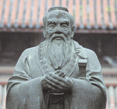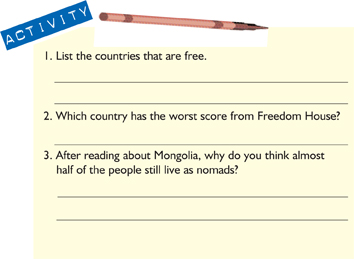How Has History Affected the People of East Asia?
Who Are the People of East Asia?, What Is East Asia Like Today?
Look back at the Land Use and Monsoon Map of Asia on page 77. Locate China, Japan, North Korea, South Korea, Taiwan, and Mongolia. These countries make up East Asia. The region is huge. It has many landforms—from Mount Everest to the Gobi Desert. China takes up most of the land. In fact, it is the world's third largest country.
For thousands of years, China has had an influence on the people of East Asia. Culture and traditions from China flowed to the Korean peninsula, Mongolia, Taiwan, and Japan. Over time, powerful dynasties joined parts of China into one country. A dynasty is a line of rulers from a single family.
By the 1500s B.C., China's first dynasty ruled the country. The Shang dynasty invented a calendar based on the cycles of the moon. They also created a writing system. Later on, Japan used some of these symbols in their own writing.
Ancient Chinese believed that the ruler of a dynasty was a god. People believed that heaven chose their rulers. This idea was called the Mandate of Heaven. It gave power to the rulers. It also gave people the right to overthrow bad rulers.
China had eleven major dynasties. One important dynasty was the Han. They ruled from 206 B.C. to A.D. 226. The Han set up a new form of government. They used the ideas of a teacher named Confucius (kuhn-fyoo shus). Confucianism taught people to study hard and respect their parents. People must also obey their rulers. The teachings of Confucianism spread throughout all of East Asia.
The Han had many accomplishments. They invented paper. They also invented the sundial to tell time and the compass to tell direction. Many of these ideas spread across East Asia.
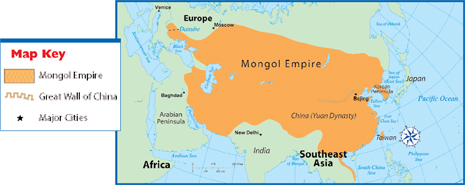 Map of Mongol Empire, A.D. 1294
Map of Mongol Empire, A.D. 1294
In about 221 B.C., China began building the Great Wall. It was used to protect China from invading nomads. Eventually, the wall snaked more than 4,000 miles (6,437 km). It stood from the Yellow Sea in the east to the deserts in the west.
Among the groups attacking China were the Mongol nomads. These fierce warriors roamed the northern plains. Their armies were skilled horsemen. In 1279, a Mongol named Kublai Khan (koo-bluh kahn) became ruler of the Mongol Empire. He conquered China. This began the Yuan (you-ahn) dynasty. For the first time, foreigners ruled all of China.
Look at the map. The Mongol Empire included most of East and Central Asia as well as part of Europe! It was the largest empire in history. It stretched from the Pacific Ocean to the Mediterranean Sea.
These invaders spoke a different language. They practiced a different religion. The Chinese resented the Mongol way of dress and their customs. Kublai Khan did not force the Chinese to adopt Mongol ways. Some Mongols even adopted parts of Chinese culture.
In 1281, the Mongols tried to attack Japan. Strong storms destroyed their ships. Japan was saved. About 1368, Chinese armies defeated the Mongols. The Chinese leader set up the Ming dynasty. Over time, Ming rulers led China into isolationism. Isolationism is a policy of avoiding contact with other countries. From that time, China began to lose power in the world.
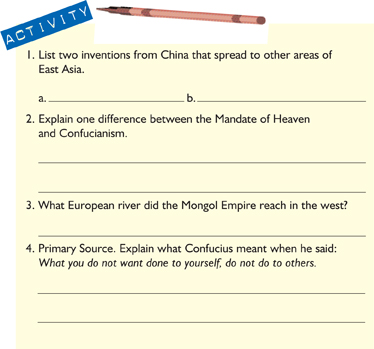
Who Are the People of East Asia?
In the United States, many different ethnic groups live together. In most big cities, you can find a Chinatown or a Little Italy. You can find stores that sell Spanish or Polish i foods. You can hear many different languages. In East Asia, most countries have one main ethnic group. They share the same traditions.
In China, most people belong to a group called the Han. The name comes from the great Han dynasty. They believed that China was the center of the world. In fact, the symbols for China mean the “Middle Kingdom.” The main language is Mandarin. There are other spoken languages in China, but only one written language. If you write a word, everyone in China can understand you.
In China, people still celebrate their oldest holiday, the Dragon Boat Festival. They race boats that are shaped like dragons. Special rice dumplings are a treat for everyone. People hope that they will be protected from evil and disease for the rest of the year.
During the Chinese New Year, people line the streets to watch dancing dragons weave their way through the streets. Trained dancers are inside the dragon. They twist and turn the dragon's body as it moves down the street. Most countries in East Asia celebrate the New Year.
A visit to Mongolia in July is special. For three days, the whole country celebrates naadam, or “games.” In fact, Mongolia is home to the second-oldest Olympics. The festival begins with a colorful parade. Many people wear warrior clothing. There are horse races, wrestling, and archery contests.
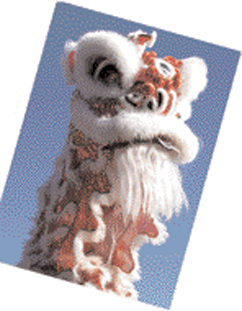 A Chinese Dragon used to celebrate the Chinese New Year
A Chinese Dragon used to celebrate the Chinese New Year
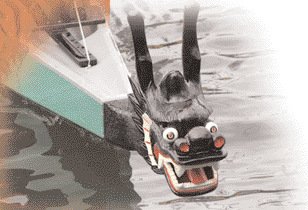 A race boat used in the Dragon Boat Festival
A race boat used in the Dragon Boat Festival
Koreans were descended from many different groups of nomads from Mongolia. As centuries passed, these groups lost their separate traditions. They became one group, with the same language and customs.
Today, Korean families still celebrate a Harvest Moon Festival called chusok (choo-suk). It is similar to Thanksgiving in the United States. The family wears traditional clothing. They visit the graves of ancestors, or family members who died. Families leave a gift of special foods. The Koreans are also famous for kimchi. This dish is made with pickled cabbage and various spices.
Like China, Japan also cut itself off from the rest of the world. Because of this history, nearly all of the people belong to the same ethnic group. They share the same language, traditions, and religion.
Like other countries, Japan has many holidays. One important celebration is tanabata (tahn-ah-bah-ta). People tie small pieces of paper onto tree branches. Prayers are written on the papers. When the wind blows, the prayers are carried to their ancestors.
In the 600s, the Chinese began settling Taiwan. Over the years, both China and Japan have controlled Taiwan. The people are descendents of Chinese people. Chinese culture has shaped Taiwan's culture.
In Taiwan, people celebrate a Lantern Festival called the Shang Yuan Festival. Lanterns in the shape of birds and beasts are carried by children. People also celebrate by eating a special dish called yuan hsiao. This is a rice dumpling filled with bean J paste and meat or fish.
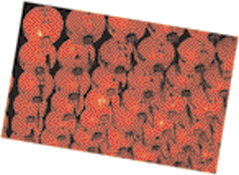 Lanterns are lit in Taiwan to celebrate the Shang Yuan Festival.
Lanterns are lit in Taiwan to celebrate the Shang Yuan Festival.
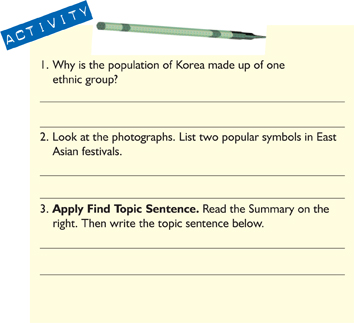
What Is East Asia Like Today?
After World War II (about 1945), East Asia grew into a powerful region. Japan, Taiwan, and South Korea exploded with growth. They built new factories and businesses. People had jobs and comfortable houses. Health and education improved. The standard of living increased.
These three countries are also democracies. People have freedom of speech and vote for their leaders. They can own property. The government of Japan is a constitutional monarchy. This is a form of government in which a king or queen is the head of state but has limited powers. Japan has an emperor, which is like a king. The emperor is head of state, but has no power. He is a symbol of Japan.
China and North Korea are communist countries. The communist party runs the government. The economy is planned by the state. North Korea follows a path of isolationism. They have very little contact with other countries. Government policies kept these two countries very poor.
In the 1980s, China changed its policies. The economy is now growing fast. Some people can own businesses. Today, China is a world economic force. Many people have moved to the cities to find factory jobs. Their standard of living is better. But farmers in rural areas are still very poor. Wages are low. This fast growth has created serious environmental problems. Cars and factories pollute the air and water. Like many growing countries, China is also losing forests and farmlands to factories and cities.
Mongolia is slightly larger that Alaska. Almost half of the people still herd animals. Because of their nomadic way of life, Mongolian culture stresses the importance of horse skills. Even in the cities, many Mongolians still live in tents called yurts. They speak their own language.
For many years, Mongolia was influenced by the Soviet Union. When the Soviet Union collapsed in 1991, Mongolians worked to I build a democratic government. The number of people moving to the cities is increasing. The urban population is growing slowly. Because the land is so rugged and wild, the people of Mongolia still face shortages of food and water.
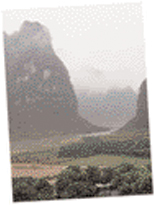 North Korea countryside
North Korea countryside
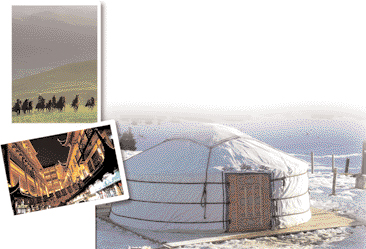 Horse skills are still important in Mongolian culture.
Horse skills are still important in Mongolian culture.
Shanghai, China
This tent-like dwelling is called a yurt.
Who Is Free in East Asia?
This map is based on information from Freedom House. This organization formed in the 1940s. It works to support democratic values around the world. Every year it gives a score for every country. Freedom house gives two scores. One is for political rights—does a country allow different political parties and can people freely vote?
Freedom House also scores civil liberties—does the country protect the rights and freedoms of its citizens? The scores range from 1 (the best) to 7 (the worst).
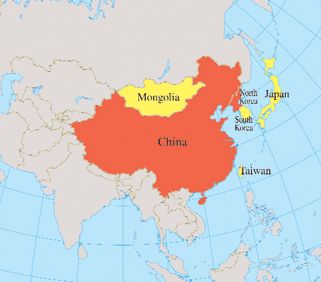
| Country | Political Rights | Civil Liberties | |
|---|---|---|---|
| China | 7 | 6 | |
| Mongolia | 2 | 2 | |
| North | Korea | 7 | 7 |
| South Korea | 1 | 2 | |
| Taiwan | 2 | 2 | |
| Japan | 1 | 2 |
Additional topics
- How Has History Affected the People of Central Asia? - Who Are the People of Central Asia?, What Is Central Asia Like Today?
- What Is the Geography of Asia? - What Is the Climate Like?, How Is the Land in Asia Used?
- Other Free Encyclopedias
History Reference: Ancient History & World HistoryThe Eastern Hemisphere - Asia


